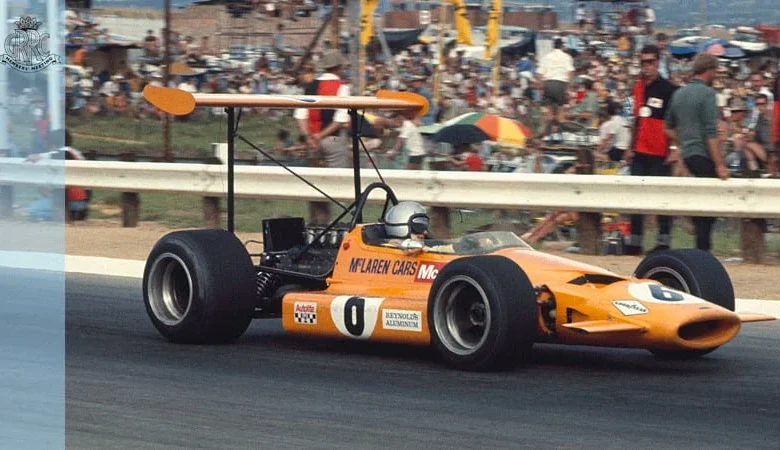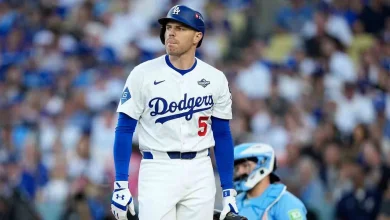The name behind the race: Bruce McLaren

Bruce McLaren’s story is one of ingenuity, perseverance, and unshakable optimism — a man who refused to accept limits, mechanical or physical, grit that took him from the confines of a childhood hospital bed to the pinnacle of motorsport.
McLaren was born in August 1973 in Aukland, to Les and Ruth, both avid motor racing fans who competed on two and four wheels. Their enthusiasm filled the family’s modest home, which sat directly above their service station and workshop, a place that would become Bruce’s playground and classroom.
At the age of nine, McLaren was diagnosed with a degenerative hip disorder that left him bedridden for months and unable to walk for years. He spent three years in the Wilson Home for physically disabled children in Takapuna, enduring traction, plaster casts and long periods in a wheelchair. When he eventually stood again, he did so with a limp, and with the fierce determination that would shape the rest of his life.
The Bruce McLaren Trophy
Find out more
As soon as he could, McLaren was back in his father’s garage, soaking up everything he could about engines, gearboxes and fabrication. Surrounded by tools and petrol fumes, he built his first racing car before he was even old enough to hold a licence — a 1929 Austin 7 Ulster, bought by his father for $110 and intended for resale. The young McLaren had other ideas.
Two years were spent painstakingly restoring and modifying the little Austin using second-hand parts, boosting its top speed from 72 mph to 87 mph. When his father was unable to race McLaren stepped in, under his father’s name and under the legal age. Victory here was the first step in a remarkable career.
By 1956, McLaren was studying engineering at the University of Auckland, but his heart wasn’t in the classroom. His student record would later be marked with a simple and fitting epitaph: “Went motor racing.”
Bruce’s fifth-place finish in the 1957 New Zealand Grand Prix brought him into the spotlight, and though gearbox troubles hampered his next attempt, his talent was clear. He became the first recipient of the “Driver to Europe” scholarship, designed to help promising young New Zealanders break into international racing.
Once in Europe, McLaren’s rise was swift. He caught the attention of fellow Antipodean Jack Brabham, who convinced the Cooper Car Company to give him a Formula 2 drive. Calm, precise and unflappable, McLaren quickly earned a reputation as both fast and mechanically sympathetic — qualities that made him invaluable in an era when cars were fragile and races brutal.
At the 1958 German Grand Prix, driving an F2 Cooper, he stunned the paddock by finishing fifth overall, ahead of several F1 entrants. A year later, he graduated to the full Cooper Formula 1 team alongside Brabham.
The results came almost immediately. Third at the British Grand Prix was followed by victory in the 1959 United States Grand Prix at Sebring. At just 22 years and 104 days old, Bruce became the youngest winner in F1 history — a record that stood for more than four decades.
He finished the 1959 season sixth overall, then followed it up with wins in Argentina and second place in Monaco the next year, ending the 1960 Championship as runner-up to Brabham himself. By 1962, McLaren was Cooper’s lead driver, scoring another Monaco victory and third overall in the standings.
But Cooper’s dominance was waning. Bruce could see that the team’s technical edge was slipping, and for a man of his ambition and engineering curiosity, the idea of building his own cars became irresistible.
In 1963, McLaren founded Bruce McLaren Motor Racing Ltd in a small workshop in New Malden. The goal was simple: to design and build racing cars that could compete at the highest level.
A year later, the fledgling operation moved to larger premises in Feltham, where the team built the prototype M1 sportscar — the first to carry the McLaren name. That same year, McLaren won the New Zealand Grand Prix, part of the new Tasman Series for 2.5-litre cars, proving both his engineering vision and his ability to run a team while still competing at the front.
By 1965, McLaren had left Cooper for good. He already had two Australian Grand Prix wins, three F1 victories and 17 podiums to his name, but the real adventure was just beginning.
The 1966 Formula 1 rule changes created the perfect opening. With backing from Firestone, BP, and a close relationship with Ford — whose GT40 he famously helped to victory at Le Mans that same year — Bruce set about building his first F1 car.
He hired Robin Herd, a young aerospace engineer fresh from the Concorde programme, to design the M2B. Its chassis was made of Mallite, a sandwich of aluminium and balsa wood that was both light and rigid, decades ahead of its time. Unfortunately, the same couldn’t be said of its engine or gearbox, which proved heavy and unreliable.
Still, McLaren debuted the M2B at the 1966 Monaco Grand Prix and scored his first three points that season. It was a modest return, but a monumental step: a privateer had built and raced his own Formula 1 car.
Two years later, that vision was rewarded. In 1968, McLaren arrived at the fearsome Spa-Francorchamps circuit with his M7A — lighter, faster and finally competitive.
Qualifying was difficult; it was raining heavily, the surface slick and treacherous, and McLaren could only manage seventh. But he knew Spa’s dangers well and took a conservative approach, a strategy that paid off.
One by one, the leaders fell away and McLaren climbed steadily through the chaos. As he crossed the line he believed he had finished second to Jackie Stewart, only later did he learn the Scotsman had stopped for fuel on the final lap. It was a rival mechanic who broke the news: “You’ve won, didn’t you know?”
Bruce McLaren had become only the third man — after Brabham and Dan Gurney — to win a Grand Prix in a car he’d designed. No one has repeated the feat since.
The M7A’s successor, the M7C, arrived the following year, bristling with innovation. Nicknamed “the Thursday car,” it debuted with a dramatic front-mounted spoiler (immediately banned) and refined aerodynamics that helped McLaren finish third in the 1969 Championship.
Simultaneously, the team was rewriting history across the Atlantic in the Can-Am series, where the combination of minimal regulations and massive engines created the most powerful sportscars in the world.
In just 11 weeks, McLaren and his small crew built the M6A, a sleek, low-slung monster powered by a Chevrolet V8. Its monocoque chassis was light yet strong, its wedge-shaped body produced useful downforce, and its papaya paint — chosen by business partner Teddy Mayer to stand out on black-and-white television — became a brand signature still used today.
The team dominated the 1967 Can-Am season, winning five of six races. McLaren became Champion, with new teammate and compatriot Denny Hulme close behind.
For 1968, the team introduced the M8A, featuring an all-aluminium big-block Chevy engine integrated into the chassis. It proved brutally effective, winning four of six races, this time McLaren finishing runner-up to Hulme.
Then came 1969, the year of total domination. The Can-Am calendar had expanded to 11 rounds and the papaya cars won them all. McLaren claimed the Championship 15 points clear of Hulme, sealing the team’s reputation as an engineering powerhouse.
By 1970, Bruce McLaren was a global star — a race winner in F1, Le Mans and Can-Am, and a constructor whose cars were admired for their innovation and reliability. He was just 32 years old.
On 2nd June that year, McLaren took to the Goodwood Motor Circuit to test his latest Can-Am creation, the M8D. It was a new design, featuring a towering rear wing and immense power. As he accelerated down the Lavant Straight, the car suddenly lost aerodynamic stability, veered off track and struck a flag marshal’s bunker. He was killed instantly.
The shock was devastating. McLaren wasn’t merely a team boss; he was its heart. Two days after the accident, his close associate Teddy Mayer gathered the team at the factory.
“We don’t have a boss, we don’t have a driver and we don’t even have a car,” he told them. “But we have a race in two weeks’ time — and we owe it to Bruce to race.”
Twelve days later, the McLaren team won at Mosport in Canada with Dan Gurney behind the wheel. It was a victory tinged with grief but also triumph, a sign that McLaren’s vision lived beyond him.
In the half-century since his death, McLaren has evolved into one of the most successful and recognisable names in motorsport. The team has claimed ten Formula 1 Constructors’ Championships, 12 Drivers’ Titles, two Indy 500 wins and victory at the Le Mans 24 Hours. Its road-car division continues McLaren’s philosophy of engineering excellence and innovation, producing icons like the McLaren F1, P1, and Speedtail.
Yet beyond the trophies and technology, Bruce McLaren’s greatest legacy is the culture he created — a belief that teamwork, curiosity and courage can conquer any obstacle. Bruce once captured his philosophy in a few simple, unforgettable words:
“To do something well is so worthwhile that to die trying to do it better cannot be foolhardy. It would be a waste of life to do nothing with one’s ability, for I feel that life is measured in achievement, not in years alone.”
Every McLaren car, from the roaring Can-Am monsters to today’s F1 leaders, carries that spirit. The restless pursuit of excellence is the legacy of Bruce McLaren.
The 83rd Members’ Meeting presented by Audrain Motorsport takes place on the 18th & 19th April 2026. Tickets are on sale now for GRRC Members and Fellows.
You can sign up for the Fellowship now. Click here to find out more.
Images courtesy of Getty Images.
-
members’ meeting
-
83mm
-
event coverage
-
Bruce Mclaren
-
Bruce McLaren Trophy
-
Bruce McLaren Trophy info





